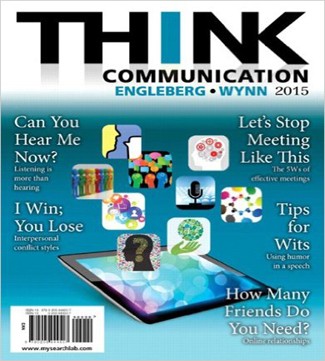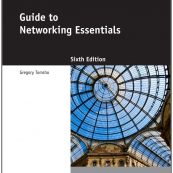THINK Communication 3rd Edition Engleberg Wynn Test Bank
$38.00
THINK Communication 3rd Edition Engleberg Wynn Test Bank Download
- Description
- Reviews (0)
Description
You will receive this product immediate after placing the order
ISBN-10: 0205944507
ISBN-13: 9780205944507 978-0205944507
3
Adapting to Others
3.1 MULTIPLE CHOICE
3.1-1. Culture is defined as a learned set of ___________________ about beliefs, values, norms, and social practices that affect the behaviors of a relatively large group of people.
a. perceptual sets
b. shared understandings
c. shared interpretations
d. cultural acts
e. cultural behaviors
Answer: c
Skill Level: Factual
Difficulty: 1. Easy
Page Ref: 42
LO: 3.1
Topic: The Many Faces of Others
3.1-2. Groups of people who coexist within the mainstream of society, who remain connected to their cultural heritage, are known as
a. cultures.
b. co-cultures.
c. nationalities.
d. ethnicities.
e. races.
Answer: b
Skill Level: Factual
Difficulty: 1. Easy
Page Ref: 42
LO: 3.1
Topic: The Many Faces of Others
3.1-3. People who believe that their culture is a superior culture with special rights and privileges that are or should be denied to others would be classified as
a. ethnocentric.
b. discriminatory.
c. prejudiced.
d. stereotypical.
e. racist.
Answer: a
Skill Level: Factual
Difficulty: 1. Easy
Page Ref: 44
LO: 3.2
Topic: Barriers to Understand Others
3.1-4. Which of the following religions is the oldest?
a. Christianity
b. Islam
c. Judaism
d. Buddhism
e. Hinduism
Answer: e
Skill Level: Factual
Difficulty: 2. Moderate
Page Ref: 44
LO: 3.1
Topic: The Many Faces of Others
3.1-5. __________ is a monotheistic religion (belief in one God) just like Christianity.
a. Islam
b. Hinduism
c. Buddhism
d. Daoism
e. Shintoism
Answer: a
Skill Level: Factual
Difficulty: 2. Moderate
Page Ref: 44
LO: 3.1
Topic: The Many Faces of Others
3.1-6. If you have positive or negative attitudes about an individual or cultural group based on little or no direct experience with that person or group, you would be classified as
a. racist.
b. stereotypical.
c. ethnocentric.
d. discriminatory.
e. prejudiced.
Answer: e
Skill Level: Factual
Difficulty: 2. Moderate
Page Ref: 45
LO: 3.2
Topic: Barriers to Understand Others
3.1-7. After Hurricane Katrina, many minorities were prevented from moving into particular neighborhoods due to newly established laws about property ownership. These laws were found to be __________________ because they excluded certain groups of people from the opportunity to choose where to live—an opportunity that was granted to others.
a. racist
b. stereotypical
c. ethnocentric
d. discriminatory
e. prejudiced
Answer: d
Skill Level: Applied
Difficulty: 3. Hard
Page Ref: 45
LO: 3.2
Topic: Barriers to Understand Others
3.1-8. Someone who is ___________ assumes that a person with a certain inherited characteristic also has negative characteristics and abilities.
a. racist
b. stereotypical
c. ethnocentric
d. discriminatory
e. prejudiced
Answer: a
Skill Level: Factual
Difficulty: 2. Moderate
Page Ref: 46
LO: 3.2
Topic: Barriers to Understand Others
3.1-9. Numerous studies searching for scientific proof of biological differences among racial groups have reached the following conclusion:
a. There are only three identifiable races: European, African, and Asian.
b. There are no pure races: 99.9 percent of DNA sequences are common to all humans.
c. The human species, homo sapiens, had its origins in China.
d. There are only three pure races: European, African, and Asian.
e. There are only five identifiable races: Caucasians, Malays, Native Americans, Ethopians, and Mongolians.
Answer: b
Skill Level: Factual
Difficulty: 2. Moderate
Page Ref: 47
LO: 3.2
Topic: Barriers to Understand Others
3.1-10. According to Hofstede’s dimensions of culture, the United States can be classified as a(n) __________ nation.
a. collectivist, low power distance, and feminine
b. individualistic, high power distance, and masculine
c. individualistic, low power distance, and feminine
d. individualistic, low power distance, and masculine
e. collectivist, low power distance, and masculine
Answer: d
Skill Level: Factual
Difficulty: 3. Hard
Page Ref: 47
LO: 3.3
Topic: The Dimensions of Culture
3.1-11. According to intercultural communication scholars Myron Lustig and Jolene Koester, each dimension of culture can be viewed as a continuum of ___________ that a culture must make, rather than either/or categories.
a. beliefs
b. actions
c. interpretations
d. choices
e. attitudes
Answer: d
Skill Level: Factual
Difficulty: 2. Moderate
Page Ref: 47
LO: 3.3
Topic: The Dimensions of Culture
3.1-12. In a collectivist culture,
a. there is greater readiness to cooperate with others.
b. individual uniqueness is an important value.
c. independence is worth pursuing.
d. personal achievement is rewarded.
e. None of the above is characteristic of a collectivist culture.
Answer: a
Skill Level: Understand
Difficulty: 2. Moderate
Page Ref: 47
LO: 3.3
Topic: The Dimensions of Culture
3.1-13. Collectivist cultures place greater value on
a. uncertainty.
b. esteem and self-actualization.
c. personal freedom.
d. collaboration and cooperation.
e. competition.
Answer: d
Skill Level: Factual
Difficulty: 2. Moderate
Page Ref: 47
LO: 3.3
Topic: The Dimensions of Culture
3.1-14. __________ is the most individualistic country or region in the world.
a. Guatemala
b. Indonesia
c. United States
d. Pakistan
e. West Africa
Answer: c
Skill Level: Factual
Difficulty: 1. Easy
Page Ref: 48
LO: 3.3
Topic: The Dimensions of Culture
3.1-15. According to Hofstede, the people of Malaysia, Guatemala, the Philippines, and Mexico live in a(n) __________ culture.
a. individualistic
b. high power distance
c. low power distance
d. feminine
e. short-term time
Answer: b
Skill Level: Factual
Difficulty: 2. Moderate
Page Ref: 48
LO: 3.3
Topic: The Dimensions of Culture
3.1-16. In low power distance cultures,
a. people accept differences in power as normal.
b. people believe that all people should be treated as equal.
c. people of privilege and wealth have much more power.
d. people accept and rarely challenge authority.
e. the government, corporations, and religious authorities may dictate rules of behavior and have the power to ensure compliance.
Answer: b
Skill Level: Factual
Difficulty: 1. Easy
Page Ref: 48
LO: 3.3
Topic: The Dimensions of Culture
3.1-17. Which of the following countries is the lowest power distance culture?
a. Malaysia
b. Austria
c. Guatemala
d. Philippines
e. Mexico
Answer: b
Skill Level: Factual
Difficulty: 2. Moderate
Page Ref: 49
LO: 3.3
Topic: The Dimensions of Culture
3.1-18. Which cultural dimension would be characterized by the following components: (1) subordinates should be consulted; (2) privileges and status symbols are frowned upon, (3) parents treat their children as equals, and (4) teachers expect students to express their opinions in class?
a. individualism
b. collectivism
c. polychronic
d. low power distance
e. high power distance
Answer: d
Skill Level: Applied
Difficulty: 2. Moderate
Page Ref: 49
LO: 3.3
Topic: The Dimensions of Culture
3.1-19. The gender expectations dimension focuses on expectations about suitable
a. role behaviors.
b. cultural norms.
c. differences.
d. values.
e. nurturing behaviors.
Answer: a
Skill Level: Factual
Difficulty: 1. Easy
Page Ref: 49
LO: 3.3
Topic: The Dimensions of Culture
3.1-20. According to Hofstede’s dimensions of culture, which of the following countries is ranked the highest in terms of masculine values?
a. U.S.A.
b. Japan
c. Italy
d. Mexico
e. Israel
Answer: b
Skill Level: Factual
Difficulty: 2. Moderate
Page Ref: 49
LO: 3.3
Topic: The Dimensions of Culture
3.1-21. Which dimension of culture best explains why, in places such as India, Kenya, and Argentina, people are driven less by a need to “get things done” and more by a sense of participation in events that create their own rhythm?
a. individualism-collectivism
b. power distance
c. gender expectations
d. time orientation
e. high-low context
Answer: d
Skill Level: Applied
Difficulty: 2. Moderate
Page Ref: 50
LO: 3.3
Topic: The Dimensions of Culture
3.1-22. Which theory explains that powerful, wealthy groups at the top of a society determine who will communicate and be listened to?
a. Hofstede’s Dimensions of Culture
b. Kramarae’s Muted Group Theory
c. Crawford’s Mediated Communication Theory
d. Blumenbach’s Racial Discrimination Theory
e. Prothero’s Religious Literacy Theory
Answer: b
Skill Level: Factual
Difficulty: 2. Moderate
Page Ref: 50
LO: 3.3
Topic: The Dimensions of Culture
3.1-23. In high context cultures, messages are
a. implicit.
b. explicit.
c. objective.
d. factual.
e. direct.
Answer: a
Skill Level: Factual
Difficulty: 2. Moderate
Page Ref: 51
LO: 3.3
Topic: The Dimensions of Culture
3.1-24. People who share beliefs such as “The duck that squawks gets shot,” or “Seeing is better than hearing,” would be characterized as members of a(n) __________ culture.
a. individualistic
b. high context
c. polychronic
d. low uncertainty
e. high power
Answer: b
Skill Level: Applied
Difficulty: 3. Hard
Page Ref: 51
LO: 3.3
Topic: The Dimensions of Culture
3.1-25. Which of the following statements would be made by someone from a low context culture?
a. “I rely on facial expressions to interpret what others mean.”
b. “Feelings are a valuable source of information.”
c. “I try to maintain harmony in my communication with others.”
d. “I like to be accurate, clear, and direct when I talk to others.”
e. “I communicate in an indirect fashion.”
Answer: d
Skill Level: Applied
Difficulty: 3. Hard
Page Ref: 51
LO: 3.3
Topic: The Dimensions of Culture
3.1-26. Which of the following is a low-context culture?
a. Chinese
b. German
c. Mexican American/Latino
d. African American
e. South Korean
Answer: b
Skill Level: Factual
Difficulty: 3. Hard
Page Ref: 52
LO: 3.3
Topic: The Dimensions of Culture
3.1-27. Mindfulness involves being fully aware—in your _________________, emotional feelings, and conscious mind—of the present moment without making judgments.
a. cognitive thoughts
b. stereotypical thinking
c. physical body
d. interpretations
e. logical judgments
Answer: c
Skill Level: Factual
Difficulty: 2. Moderate
Page Ref: 53
LO: 3.4
Topic: Intercultural Communication Strategies
3.1-28. Two co-workers are from different parts of the United States—one from Maine and the other from Alabama. While they have different dialects, they use a similar, more formal speaking style in professional settings. Which strategy of intercultural communication are they using?
a. being mindful
b. adapting to others
c. actively engaging others
d. being receptive to new information
e. respecting others’ perspectives
Answer: b
Skill Level: Factual
Difficulty: 2. Moderate
Page Ref: 54
LO: 3.4
Topic: Intercultural Communication Strategies
3.1-29. Howard Giles’ Communication Accommodation Theory
a. advocates mindfulness.
b. contrasts Western and Asian ways of thinking.
c. explains why collectivist and individualistic cultures have difficulty reaching agreement.
d. claims that when another group is attractive and powerful, we adapt our communication style to their speech behaviors and norms.
e. contends that ethnocentrism and stereotyping leads to racism.
Answer: d
Skill Level: Factual
Difficulty: 2. Moderate
Page Ref: 55
LO: 3.4
Topic: Intercultural Communication Strategies
Be the first to review “THINK Communication 3rd Edition Engleberg Wynn Test Bank”
You must be logged in to post a review.














Reviews
There are no reviews yet.